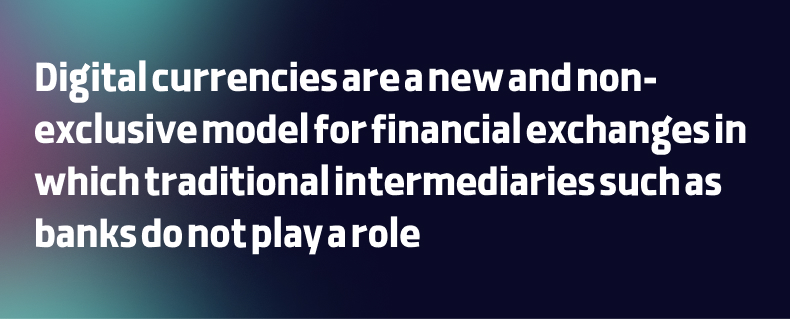Digital currency, which is based on the science of cryptography, has created a revolution in the way of financial exchange and store of value. Unlike traditional currencies that are under the supervision and control of central institutions, these emerging currencies are decentralized in nature. This feature means that no government or organization has the power to control and manipulate these currencies; additionally, transactions related to cryptocurrencies are carried out directly and without intermediaries between the parties.
This brings about several advantages, including lower fees and faster transaction speed. The main platform for cryptocurrency activity is blockchain technology. This technology ensures the transparency and security of transactions by creating a distributed and immutable ledger. If you want to learn more about digital currencies and how they work, the advantages and disadvantages of crypto and how to buy and sell them, stay with us.
Click here to buy and sell digital currency on the secure platform of Coinverse exchange.
What is “Cryptocurrency”?
Cryptocurrency or digital currency is a type of electronic money that is created and exchanged between users using complex encryption algorithms. This virtual money is known as cryptocurrency and allows the transfer of capital without border restrictions. Cryptography is the clear distinction between digital money and traditional money (fiat) and prevents forgery and fraud in this system.
The idea of forming digital currencies and the cryptocurrency market, was a response to two big challenges in traditional financial systems:
- Trust in third parties
- Spending twice
When you use banks to transfer or store your money in conventional systems, you have placed complete trust in that institution. This dependence on the intermediary exists in many other matters as well, and it seems difficult to remove it.
The problem of spending money twice was solved in traditional financial systems by using balance checks by central servers, and this solution prevented people from spending the same currency twice. With the advent of Bitcoins, a decentralized solution to this problem was presented. In this system, by checking the history of transactions by all the people in the network, the possibility of cheating and spending twice was eliminated. Many people consider Bitcoin to be the first real digital currency or cryptocurrency. It is interesting to know that the idea of this new money was proposed in 2008 with the publication of the Bitcoin White Paper and its first units were mined in 2009. It should be noted that before Bitcoin there were several attempts to create digital money, but Bitcoin was recognized as the first successful electronic money by providing a comprehensive solution to the problems of trust and double spending; Cryptocurrencies also opened a new door to activities without the need to trust third parties. Several digital currencies emerged with diverse purposes; For example, Ethereum introduced itself as a platform for the development of decentralized applications (DApps) and the implementation of smart contracts, and in contrast to Ripple, by adopting a different approach, it focused on rebuilding the interbank communication system and providing a fast and low-cost payment system.
Nowadays, we are witnessing the emergence of many tokens on the platform of digital currencies such as Ethereum, EOS and Tron. These tokens use the power of the main blockchains to carry out their transactions, and each one pursues its own uses and goals.

What is the reason for the popularity of digital currencies or crypto?
The emergence of cryptocurrencies, relying on new technology, innovative ideas and their decentralized nature, has seen a huge growth among the general public, and there is a lot of desire to buy cryptocurrency around the world. Despite the fledgling nature of the field, the crypto market is highly volatile and prices can rise or fall dramatically in a short period of time. As it was mentioned before, digital currency is based on cryptography and mathematics; this ensures the security of transactions and prevents fraud. The decentralized nature of these cryptocurrencies eliminates middlemen and allows users to have more control over their assets. It is worth noting that this has attracted the attention of critics of traditional financial systems. Digital currencies establish their position in the financial world by providing innovation, security and freedom; also, despite the inherent volatility, this emerging field has significant potential to change the economic landscape in the future.
How cryptocurrencies work
Cryptocurrency systems use different mechanisms to carry out their exchanges. These various mechanisms, known as “consensus algorithms” or “collective agreement mechanisms” in blockchains, determine the way to reach a single opinion among network participants regarding the approval or disapproval of transactions. Cryptocurrency transactions are decentralized (P2P) and, depending on the chosen method, eliminate the need for intermediaries.

Features of digital currencies
In this part of the article, we are going to point out the positive features of digital currency that can convince people to use this form of financial exchange.
- Irreversibility of transactions: Digital currency transactions are irreversible after confirmation; except for the cases where the sender agrees with the refund.
- Anonymity or semi-anonymity of digital currencies: Wallet addresses, which are equivalent to account numbers or bank cards, do not contain identity information. These addresses, which consist of a sequence of letters and numbers, can identify people only by carefully examining the history of transactions and basic analysis. Some cryptocurrencies such as Monero, ZCash, and Green, focus on privacy, making identity detection extremely difficult and almost impossible.
- Global and cross-border nature of cryptocurrencies: cryptocurrencies have no geographical restrictions and can be sent anywhere in the world within minutes.
- Secure: Transactions in digital currency networks are secured by the hash power shared by individuals in proof-of-work systems; additionally, the public and private key encryption system gives users full control over digital assets and prevents third parties from accessing them.
- Non-exclusivity: There is no need to obtain permission from any person or organization to use different digital currency networks, and users can send and receive digital currency by downloading the transaction history and without the need for an intermediary.
Uses of cryptocurrency
These digital currencies, which are becoming more and more popular everyday, have a variety of uses. In this article we have mentioned 4 of these uses.
- A tool for transferring value and financial transactions with fast, low-cost, and intermediary-free transactions
- Creating a suitable platform for investing in financial markets
- Applicable in daily life and possible to use for online payments
- Implementation of smart contracts based on blockchains and providing the possibility of automatic execution of transactions and agreements, without the need for intermediaries
Read more: What is a broker? Comprehensive introduction broker
Merits of cryptocurrency
- Speedy transaction
- Increasing efficiency, transparency and reducing systemic risks due to the non-exclusivity of currencies
- Low cost of international transfers with digital currencies due to the lack of intermediaries and currency conversion
- The possibility of transferring cryptocurrencies without time and place restrictions
- Not disclosing the users’ personal information
Downsides of digital currencies
- Dramatic price changes
- Lack of strong security infrastructures in some currencies
- The complexity and difficulty of performing basic activities and the need for an authentic educational resource and a comprehensive guide
You can find reliable learning materials and in-depth manuals on Coinoverse

Different types of cryptocurrencies
Digital currencies, except Bitcoin, are divided into two categories:
- Altcoins:
- Each has an independent identity and operates on its own blockchain platform.
- Some altcoins are derived from the fundamental code of Bitcoin and are considered to be its branch or fork. These currencies are distinguished from Bitcoin by applying minor changes in parameters such as the number of coins, the mining algorithm and the time of creating blocks.
- Ethereum, Ripple, and WAVES are examples of altcoins that have built their own networks without borrowing from Bitcoin’s codes. These blockchains are designed with goals beyond financial transactions, such as providing a platform for smart contracts or facilitating supply chain management.
- Tokens:
- Tokens are created on the basis of existing platforms such as Ethereum, WAVES or EOS.
- These types of currencies do not have a separate blockchain and use the processing power of the main blockchain to perform their transactions.
- Tokens are presented to investors in the form of Initial Coin Offering (ICO) and are awarded to them in exchange for attracting capital.
- Each token has its own unique use and cannot be viewed as a monetary unit.
- Tokens are separated into two main subsets of securities tokens and utility tokens.
Read more: Calculating the trading volume in Forex
Popular digital currencies
Among the digital currencies that exist, these 5 digital currencies are the most popular:
- Bitcoin: As the first and most famous digital currency, Bitcoin has always been in the center of attention. This digital currency, which was created by Satoshi Nakamoto, is still recognized as the most valuable cryptocurrency even after more than a decade of its release.
- Ethereum: Introduced by Vitalik Buterin in 2013, this currency found a special place among digital currencies by presenting innovative ideas. In addition to its own digital currency called Ether, this platform allows the creation and supply of various tokens.
- Ripple: This popular digital currency is designed as an open-source platform with the aim of facilitating cheap and fast transactions. This payment system with support for common currencies is focused on cooperation with banks and development of its payment system and uses XRP digital currency as its proprietary cryptocurrency.
- Litecoin: Litecoin, which was created by Charlie Lee with the aim of making faster transactions and making changes to the Bitcoin codes, is known as one of the oldest altcoins. This digital currency, which is also known as digital silver among the activists of this field, has maintained its position among the best.
- Bitcoin Cash: This currency is one of the most famous forks of Bitcoin that was created in 2017 by changing the block sizes. Bitcoin Cash was split into two chains, ABC and SV, in 2018 and continues to operate.

Cryptocurrency opportunities
Digital currencies are a new and non-exclusive model for financial exchanges in which traditional intermediaries such as banks do not play a role; This makes transactions safer, faster and more efficient, and prevents crises like the 2008 crisis caused by the collapse of major investment banks. In the platform of cryptocurrencies, money transfer is done directly between the two parties of the transaction without the need for an intermediary, and this is done by using public and private keys, complex cryptography algorithms and verification of transactions. The speed of transactions in the world of cryptocurrency is significantly higher than in traditional banking systems; also, investing in digital currencies has experienced a significant growth in recent years and the market value of this field has reached more than 2 trillion dollars. As we mentioned in the features of digital currencies, these cryptocurrencies also provide users with the possibility of easy money transfer between countries.
Read more: what is a candlestick chart?
Risks of digital currency
The cryptocurrency market holds inherent complexity and extreme volatility, and investing without sufficient knowledge will result in irreparable losses. International sanctions and restrictions also have a significant impact on increasing the investment risk in digital currencies. You should bear in mind the fact that mutual funds with risk and return diversification are safe and secure options for investment.
To get guidance on reducing the risk of investing in the cryptocurrency market, contact our experts at Coinoverse.

How to buy and sell digital currency
One of the most common methods of digital currency exchange is the use of online exchanges specific to this field. These platforms provide a suitable environment for buying and selling all kinds of cryptocurrencies. Coinoverse is an international cryptocurrency exchange which is known as one of the most reliable ones. How to deposit and withdraw in Coinoverse is fully explained in this article.
The first steps of buying cryptocurrencies in Coinoverse
- First, sign up to this website (https://coinoverse.com/) and complete the authentication process.
- Having logged into your account, deposit the price that you have in mind in the form of Tether to your Coinoverse account.
- After charging your account, go to the trading platforms and buy your desired digital currency at the daily market rate.
Steps to selling cryptocurrencies in Coinoverse
- Go to the buying and selling pages on our platforms and click on the Sell button.
- Click on “Withdraw” and submit your request.
- Having thoroughly checked your request, based on the address that you’ve entered, we will/will not allow the withdrawal to be made.
Security and maintenance of cryptocurrencies
Maintaining the security of crypto currency is a major concern for all investors and activists in this new field. The non-proprietary nature of these assets makes them vulnerable to cyber-attacks; therefore, it is very necessary to take appropriate security measures to protect these funds. Nodes are responsible for monitoring the digital currency network and maintaining its security. In different networks, these nodes are selected in different ways. For example, in Bitcoin, this task is performed by miners; While in EOS and TRON networks, these nodes are selected through voting. In proof-of-stake (PoS) networks, anyone who has locked a part of their coins as collateral in the network can make decisions about transactions.
There are two main ways for people to store their cryptocurrencies:
- Digital currency exchanges: Exchanges active in this field often offer dedicated wallets on their platform that allow users to store and exchange cryptocurrencies quickly and safely.
- Digital currency wallets: These types of wallets, which are offered as software or hardware, provide the possibility of storing and sending cryptocurrencies. Although keeping cryptocurrencies in separate wallets is far more secure than exchanges, it is not without risks; because these types of wallets may be the target of cyber-attacks.
Despite the advantages and disadvantages of each of the mentioned methods, you can protect your digital assets more effectively by following the points below.
- Choosing valid wallets with high security standards
- Choose a strong password for the wallet, consisting of at least 12 characters, including upper- and lower-case letters, numbers and symbols
- Maintaining wallet access recovery phrase
- Maintaining confidentiality of information such as your username, password or recovery phrase
- Using cold or hardware wallets due to higher security

How is the future of the cryptocurrency market going to be?
The future of cryptocurrencies such as Bitcoin and Ethereum is heavily influenced by several factors, including supply and demand, public acceptance, regulations, technological innovations, macroeconomic conditions, and global events. The fluctuations of each of these factors can change the path of these types of currencies.
Despite these challenges, it is impossible to ignore the rapid growth of this market in the near future. Digital currencies are entering each industry and playing various roles, and the increasing interest of people in the crypto world promises a bright future for these types of currencies. Many investors also consider digital currencies as a suitable alternative to traditional assets such as gold and dollars.
Some experts believe that digital currency will eventually be accepted as the main means of payments and financial exchanges. Other people believe that the main use of these types of currencies will be in investment or criminal activities. These predictions show the future of digital currencies as vague but attractive for investment.
Read more: Forex Demo account; what it is and how to work with it
Conclusion
Digital currency, also known as cryptocurrency, is a type of digital asset that is based on blockchain technology and verifies and secures transactions through complex encryption. Unlike traditional currencies that are controlled by banks and governments, cryptocurrencies are decentralized in nature and not governed by any central entity. This unique feature has opened a new window to the world of economy and has brought unique opportunities to earn money. Some creative and intelligent people have achieved significant profits in this emerging market by using their knowledge and intelligence.
You can start an exciting journey in the new economic world as well with the comprehensive and practical trainings of Coinoverse; a journey that will undoubtedly bring about countless challenges and opportunities and turn you into a professional investor and trader.





